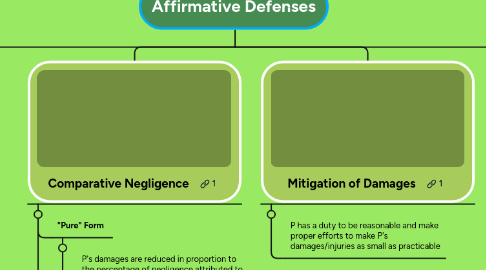
1. Contributory Negligence
1.1. If P is a superseding cause of his harm, P is totally barred from recovery, even if P's negligence is far less then D's negligence.
1.1.1. Contributory Negligence has been abolished in most states
1.1.2. States that still uphold contributory negligence:
1.1.2.1. - D.C. - Virginia - North Carolina - Alabama - Maryland
1.1.3. Last Clear Chance Doctrine
1.1.3.1. If D had sufficient time to realize and avoid the danger that injured P, then contributory negligence does not bar D from liability
2. Comparative Negligence
2.1. "Pure" Form
2.1.1. P's damages are reduced in proportion to the percentage of negligence attributed to him
2.1.2. Minority of states follow this
2.2. "Modified" Form
2.2.1. P's recover like in pure form, but only if P's negligence either (1) does not exceed 50% OR (2) is less than 49% or 51% of D's negligense
2.2.2. Majority of states follow this
2.2.2.1. Ohio follows 51% modified form
3. Mitigation of Damages
3.1. P has a duty to be reasonable and make proper efforts to make P's damages/injuries as small as practicable
4. Assumption of Risk
4.1. Parallells consent in an intentional tort
4.2. Has P done something that should bar P from recovering damages, even through D was negligent?
4.3. Express Assumption of Risk
4.3.1. D is not libale because P and D's agreement that was made in advance of P and D entering into a relationship
4.3.2. D acts in reliance to P's promise to not hold D liable
4.3.3. Exculpatory contract
4.3.3.1. This is a take it or leave it contract (like a gym membership) that relieves D of liability. UNLESS the contract was unconscionable (did P have a choice?) OR contract adversely affected the public interest
4.4. Implied Assumption of Risk
4.4.1. (1) Primary Assumption of Risk
4.4.1.1. P's recovery is completely barred because D's conduct did not breach a legal duty of care to P.
4.4.1.2. D did not have a duty to P in the first place
4.4.1.3. Instances which embody a legal conclusion that there is no duty for D to protect P from a particular risk
4.4.1.3.1. Example: Athletes have a primary implied assumption of risk of harm to types of typical injuries resulting from the sport
4.4.1.3.2. Usually used in context of sports and recreational actives
4.4.1.4. Most states do not recognize this as a defense because P's claim should be dismissed since P can not prove all elements of negligence
4.4.2. (2) Secondary Assumption of Risk
4.4.2.1. Instances where D owes a duty of care to P, but P knowingly encounters a risk of injury caused by D's breach of that duty
4.4.2.2. This doctrine is merged into the comparative fault scheme that reduces P's recovery from P's relative responsibility of the harm
4.4.2.2.1. Example: P runs into a fire, that was negligently started by D, to get P's laptop and sustains injuries from the fire
